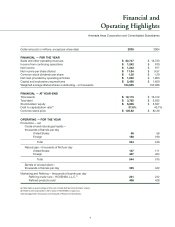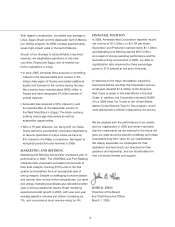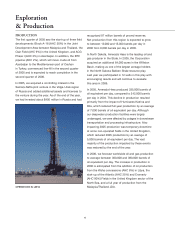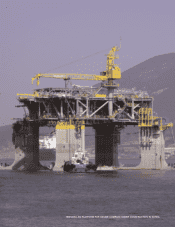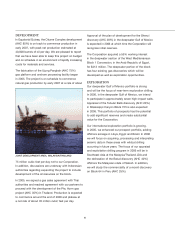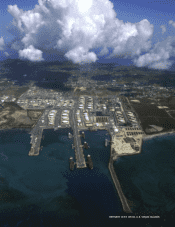Hess 2005 Annual Report Download - page 6
Download and view the complete annual report
Please find page 6 of the 2005 Hess annual report below. You can navigate through the pages in the report by either clicking on the pages listed below, or by using the keyword search tool below to find specific information within the annual report.
4
PRODUCTION
The first quarter of 2005 saw the start-up of three field
developments: Block A-18 (AHC 50%) in the Joint
Development Area between Malaysia and Thailand, the
Clair Field (AHC 9%) in the United Kingdom, and ACG
Phase I (AHC 3%) in Azerbaijan. In addition, the BTC
pipeline (AHC 2%), which will move crude oil from
Azerbaijan to the Mediterranean port of Ceyhan
in Turkey, commenced line-fill in the second quarter
of 2005 and is expected to reach completion in the
second quarter of 2006.
In 2005, we acquired a controlling interest in the
Samara-Nafta joint venture in the Volga-Urals region
of Russia and added additional assets and licenses to
the venture during the year. As of the end of the year,
we had invested about $400 million in Russia and had
recognized 87 million barrels of proved reserves.
Net production from this region is expected to grow
to between 12,000 and 15,000 barrels per day in
2006 from 6,000 barrels per day in 2005.
In North Dakota, Amerada Hess is the leading oil and
gas producer in the State. In 2005, the Corporation
acquired an additional 64,000 acres in the Williston
Basin, making us one of the largest acreage holders
in the North Dakota Bakken Shale resource play.
Last year we participated in 12 wells in this play with
encouraging results and will continue to evaluate
this area in 2006.
In 2005, Amerada Hess produced 335,000 barrels of
oil equivalent per day, compared to 342,000 barrels
per day in 2004. This decline in production resulted
primarily from the impact of Hurricanes Katrina and
Rita, which reduced full-year production by an average
of 7,000 barrels of oil equivalent per day. Although
our deepwater production facilities were largely
undamaged, we were affected by outages in downstream
transportation and processing infrastructure. Also
impacting 2005 production was temporary downtime
at some non-operated fields in the United Kingdom,
which reduced 2005 production by an average of
5,000 barrels of oil equivalent per day. The vast
majority of the production impacted by these events
was restored by the end of the year.
In 2006, we forecast worldwide oil and gas production
to average between 360,000 and 380,000 barrels of
oil equivalent per day. The increase in production in
2006 is anticipated from the addition of oil production
from the Waha concessions (AHC 8%) in Libya, the
start-up of the Atlantic (AHC 25%) and Cromarty
(AHC 90%) Fields in the United Kingdom sector of the
North Sea, and a full year of production from the
Malaysia/Thailand JDA.
Exploration
&Production
OPERATIONS IN LIBYA



